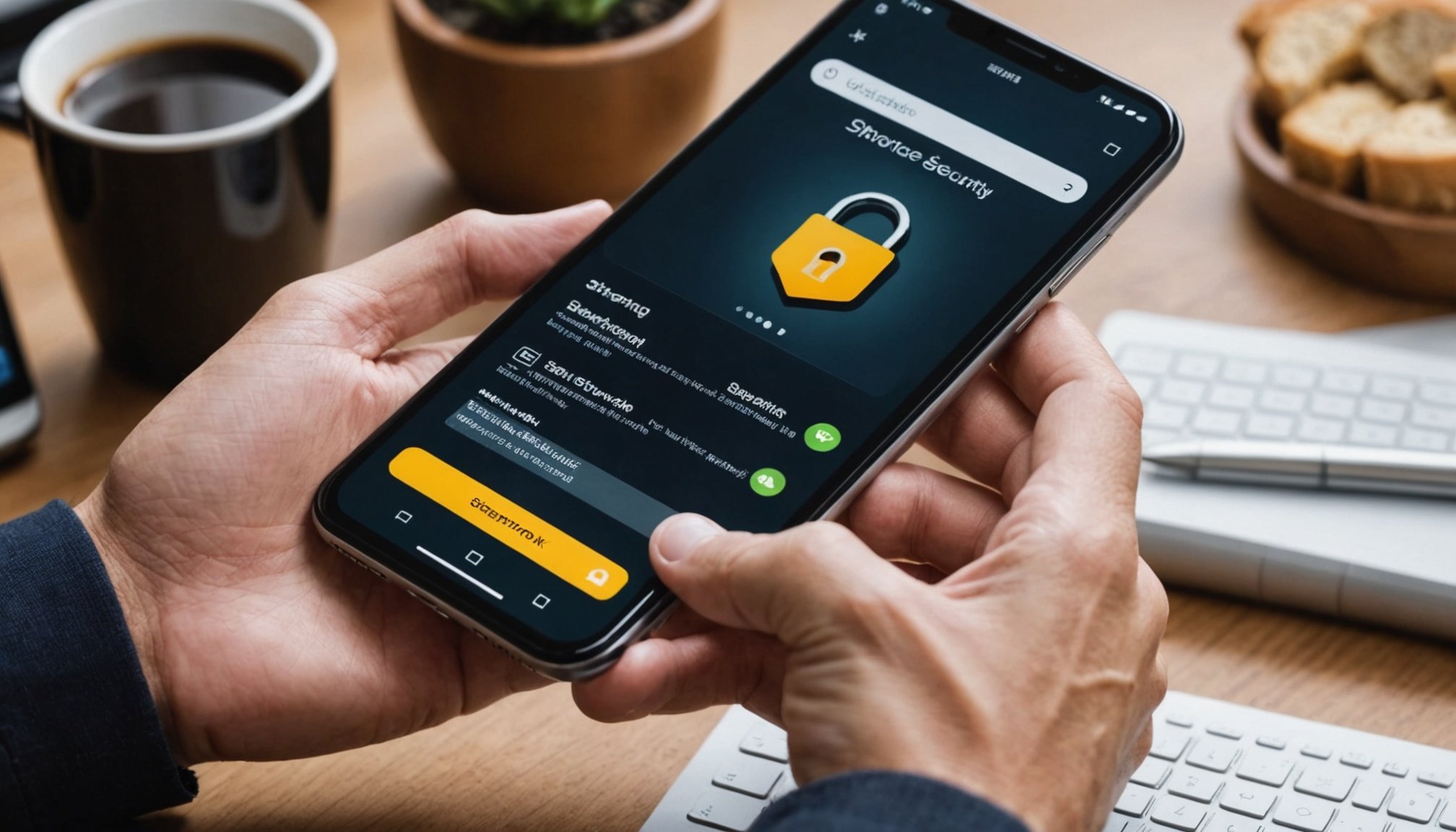Understanding Smartphone Security
In today’s digital age, smartphone security is not just a luxury but a necessity. Smartphones, our everyday companions, act as gateways to a wealth of personal data, from contacts to financial information. Maintaining robust smartphone security is crucial for protecting this sensitive information.
One of the most significant concerns in smartphone security is online shopping safety. As more users purchase goods and services through mobile devices, they face various threats, such as phishing attacks, malware, and unsecured Wi-Fi networks. These threats can lead to data breaches, identity theft, and financial loss. Therefore, users must stay informed about these risks to safeguard their personal and financial details.
In the same genre : Revamp your living room: the ultimate smartphone guide to crafting an impressive surround sound home theater
Statistics underscore the challenges in ensuring digital protection. Recent data reveal that a substantial percentage of smartphone users have, at some stage, encountered security issues during online shopping. Many of these incidents stem from weak passwords, unsecured connections, or outdated software. Establishing secure habits, such as using strong, unique passwords and staying updated with software patches, helps mitigate these risks.
Furthermore, adopting two-factor authentication and other security measures can enhance digital protection, ensuring a safer shopping experience. Emphasizing good security practices is vital for maintaining trust and safety in the digital shopping landscape.
Topic to read : Unlocking your phone”s potential: the ultimate guide to seamlessly managing your smart coffee maker
Practical Strategies for Securing Your Smartphone
Securing your smartphone is crucial as it can contain a plethora of personal information. Here, we offer practical mobile security tips to protect your device effectively.
Enabling Two-Factor Authentication
Two-factor authentication (2FA) is one of the most effective mobile security measures. It adds an extra layer of security by requiring a second form of verification, such as a code sent to your email or text message, after entering your password. By enabling 2FA, you significantly reduce the risk of unauthorized access, ensuring enhanced smartphone protection.
Importance of Strong Passwords
Utilize strong, unique passwords for all your apps and accounts. A robust password should include a mix of upper and lower-case letters, numbers, and symbols. Avoid using easily guessable information like birthdays or common words. Employing a password manager can also help keep track of your passwords securely.
Built-in Security Features
Smartphones come equipped with various built-in security features designed to protect your data. These include facial recognition, fingerprint scans, and device encryption. Activate these functions to safeguard your information further. Features like ‘Find My Device’ can be used for locating your smartphone if lost or stolen, adding a layer of smartphone protection.
Safe Online Shopping Practices
Shopping online has become a daily activity for many, but ensuring eCommerce security is crucial. Let’s delve into how you can safeguard your online transactions.
Identifying secure websites is the first step. Look for URLs starting with “https://”—this indicates a secure connection. Also, a padlock symbol in the address bar signifies a website that prioritizes transaction protection. These websites employ encryption to protect your data from malicious access.
When it comes to payment methods, using virtual payment cards can add an extra layer of security. These temporary cards link to your real account but use different credentials, thereby limiting exposure of your actual account details. Many financial institutions offer this service, which is worth considering for frequent online shoppers.
Moreover, understanding retailer privacy policies is essential. These policies outline how businesses collect, use, and protect your personal information. Always check for retailers’ data protection measures to ensure they comply with regulations such as the European GDPR or CCPA in California.
Balancing ease of shopping with security doesn’t have to be complex. By incorporating these practices, one can enhance safe online shopping experiences and reduce the risk of data breaches.
Recognizing and Avoiding Phishing Attacks
Understanding phishing awareness is essential for anyone using the internet. Online fraud prevention starts with knowing the common techniques employed by scammers. Scam detection can save both time and money by reducing the risk of falling victim to scams.
Common Phishing Techniques
One prevalent form is email phishing, where attackers impersonate credible institutions to steal sensitive information. These fraudulent emails often mimic trusted businesses, urging users to update passwords or account information. Furthermore, SMS and social media platforms are increasingly exploited with messages designed to lure victims into sharing personal details. Attackers may use convincing profiles or send direct messages to gain access to users’ financial data.
Signs of Phishing Attempts
Spotting suspicious links and attachments is vital. Always check the email’s domain and look for discrepancies or unusual requests. Fraudulent websites might look similar to legitimate ones, but subtle differences like spelling errors or unfamiliar URLs can indicate a phishing attempt.
Steps to Take if Targeted by Phishing
If you suspect an attack, securing your accounts immediately is crucial. Change your passwords and enable two-factor authentication to add an extra layer of security. Promptly report phishing attacks to authorities. Notifying them aids in online fraud prevention and can protect others from similar threats.
Recommended Security Apps
In today’s digital age, security apps are essential for protecting smartphones against a myriad of threats. With countless options available, choosing the right protection becomes crucial.
Top-rated security apps like Norton Mobile Security, Bitdefender Mobile Security, and Avast Mobile Security are designed to offer comprehensive protection. These apps are celebrated for their ability to detect and neutralize malware efficiently. They provide a combination of mobile antivirus tools and performance optimization features to keep your device running smoothly.
When selecting a security app, consider features such as real-time data protection software, anti-theft capabilities, and privacy auditing. Real-time protection ensures that incoming data is scanned for threats immediately. Anti-theft features can help locate your device if it’s lost or stolen, providing remote access to lock or delete data.
Implementing multiple layers of security can provide peace of mind. This approach encompasses using both mobile antivirus tools and data protection software to guard against threats like phishing, malware, and identity theft. The layered protection acts as a safety net, ensuring that if one layer fails, others remain intact to protect your sensitive information.
Best Practices for Password Management
Understanding password security is crucial, especially when engaging in activities like online shopping. A password manager can significantly enhance your security by storing and generating complex passwords, thus reducing the burden of remembering them. Most password managers can automatically fill login credentials, streamlining your online experience and minimizing the risk of exposure to breaches.
To bolster your authentication strategies, creating strong passwords is essential. A robust password typically includes a mix of uppercase and lowercase letters, numbers, and symbols. Regularly changing these passwords can further protect your accounts from potential threats. This practice ensures that even if one password becomes compromised, your accounts remain safeguarded.
An additional layer of security can be achieved by leveraging biometric authentication methods, such as fingerprint or facial recognition. These methods provide a unique and virtually impenetrable barrier to unauthorized access, offering peace of mind. Biometric authentication is convenient and works seamlessly with many password managers, integrating smoothly into your existing security practices.
In summary, combining a password manager, strong password creation, and biometric authentication makes for a holistic approach to protect your digital identity effectively and intelligently.
Importance of Regular Software Updates
In today’s digital age, regular software updates are crucial for maintaining system security. As technology evolves, so do the risks associated with outdated software, which can be a breeding ground for security vulnerabilities. Hackers often exploit these weak points to gain unauthorized access to systems, compromising sensitive data and overall privacy.
Software updates play a key role in safeguarding against these threats by patching known vulnerabilities promptly. These updates may include security fixes that address issues found since the previous update, ensuring your system remains as secure as possible. Moreover, updates often improve the stability and efficiency of your mobile devices and other systems, enhancing user experience.
To streamline this process, setting up automatic updates is highly recommended. This convenience ensures devices receive essential upgrades without manual intervention, reducing the likelihood of missing critical security improvements. Automatic updates not only save time but also guarantee that your systems remain protected with the most current solutions available.
By regularly updating software, users proactively defend their devices and personal information, making a small effort that yields significant protection in the ever-evolving world of cybersecurity. Embracing this practice is a fundamental step towards robust IT security.











